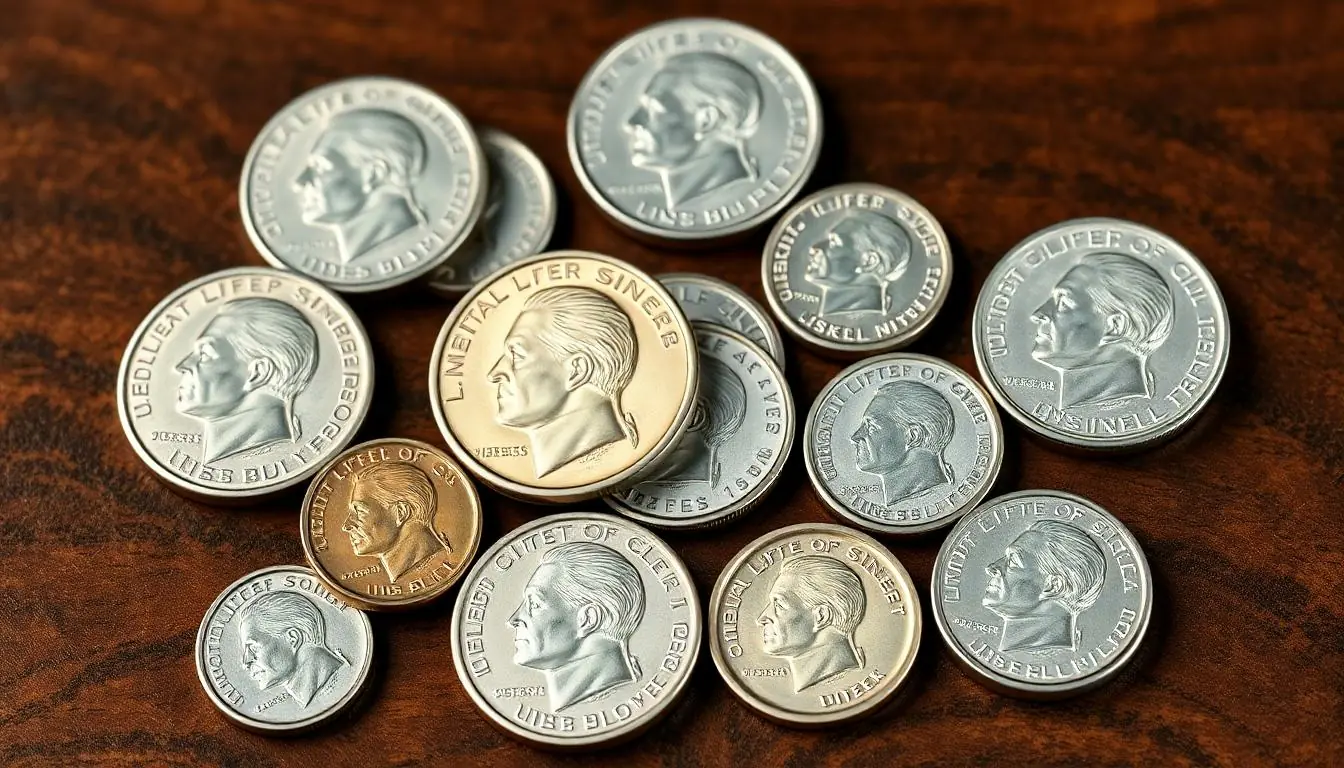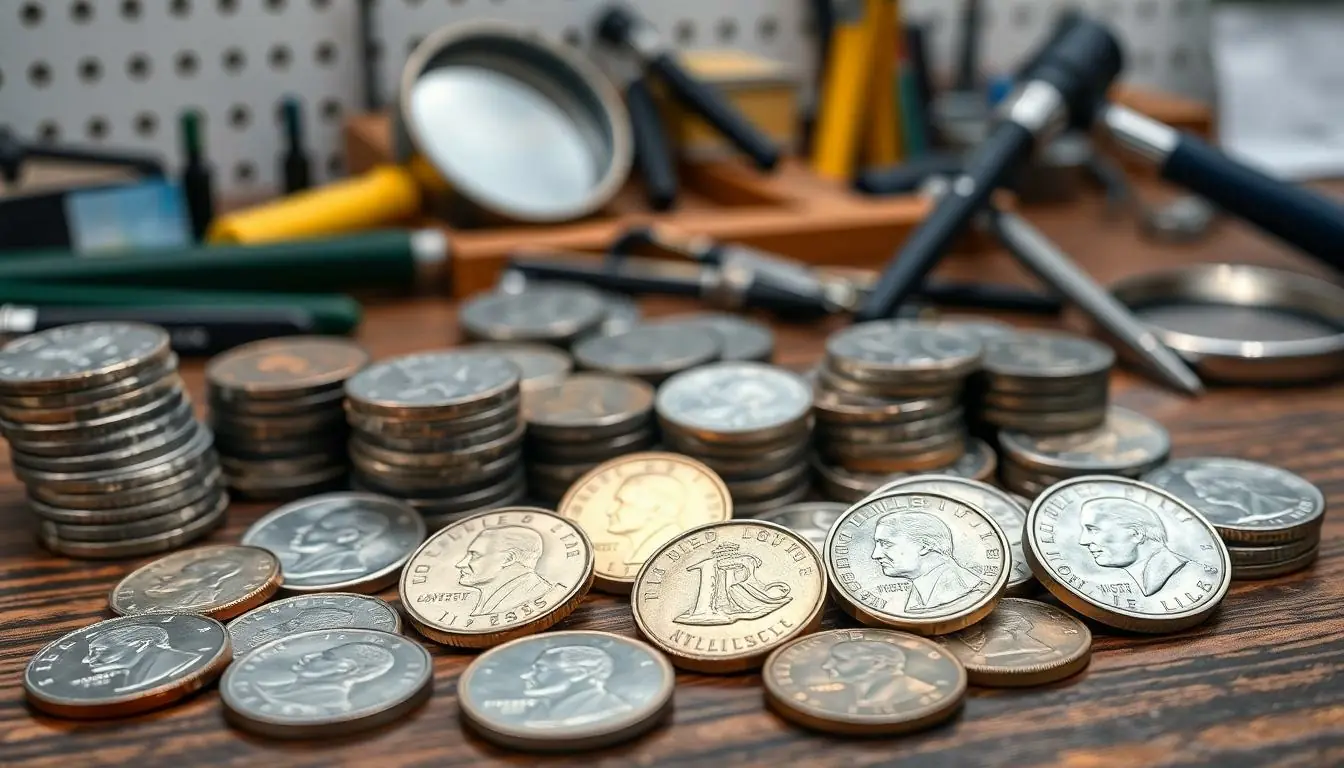In the world of coin collecting, not all nickels are created equal. While most people toss them into the nearest jar or pocket without a second thought, some modern nickels can actually pack a surprising punch when it comes to value. Imagine digging through your spare change and stumbling upon a hidden treasure that could turn your coffee run into a small fortune.
These shiny little coins may look ordinary, but certain editions are worth more than their face value. Whether it’s due to mint errors or limited releases, modern nickels can be the unexpected stars of your collection. So, before you dismiss that nickel as just another piece of pocket lint, let’s dive into the fascinating world of modern nickels worth money. Who knew your change could lead to a coin-collecting adventure?
Table of Contents
ToggleOverview Of Modern Nickels
Modern nickels date from 1965 to the present and include intriguing varieties. Specific editions can fetch higher prices due to their rarity. A 2004-D nickel, for example, with an unusual reverse die error, may be valued at over $6,000. The 1971-S nickel, minted in San Francisco, is another noteworthy mention; its price can exceed $1,000 for uncirculated examples.
Mint errors significantly contribute to a nickel’s value. Errors such as doubled dies, off-center strikes, and missing elements create unique collectibles. Collectors actively seek these anomalies, often driving up the value for nickels that may otherwise appear unremarkable.
Additionally, limited-release nickels from special commemorative events can be valuable. The 2005-2006 Westward Journey nickel series introduced designs honoring America’s westward expansion. Certain variants, especially those from low mintage years, hold a strong market demand.
Also worth noting, the condition of a nickel influences its worth markedly. Grading systems classify coins based on their physical state, with higher grades commanding premium prices. Uncirculated nickels in pristine condition can attract collectors willing to pay significantly above face value.
By examining modern nickels, collectors can uncover potential treasures. It’s beneficial to keep an eye on changes in market demand, as values fluctuate over time. Familiarity with specific coins and their histories boosts collectors’ chances of finding nickels that stand out in quality, rarity, and overall appeal.
Types Of Modern Nickels

Modern nickels come in various forms, each with unique attributes that may impact their value. Understanding these types aids collectors in identifying coins worth more than face value.
Jefferson Nickels
Jefferson Nickels debuted in 1938, featuring the profile of Thomas Jefferson. Variants from specific years attract collectors due to unique characteristics. The 1950-D Jefferson Nickel stands out as an example of a rare find, with some uncirculated examples valued above $1,500. Mintmarks on the coin indicate its origin, influencing desirability. Coins in better condition achieve higher prices in the market. Collectors often prioritize coins with attractive luster and minimal wear.
Other Variants
Other nickel variants include the War Nickel minted during World War II, notable for its unique composition. These coins contain 35% silver, making them essential to both numismatists and silver investors. The 2004 Westward Journey series introduced new designs, with certain versions growing in popularity and value. Limited mintage years also enhance rarity, such as those from 2005 and 2006. Collectors pay close attention to details, including any mint errors like double strikes, which can significantly elevate a nickel’s worth.
Factors That Determine Value
Value in modern nickels relies on several key factors. Understanding these elements can help collectors identify coins worth more than their face value.
Rarity
Rarity plays a crucial role in determining the value of a nickel. Limited mintage years, such as those from the Westward Journey series, often yield coins with fewer available specimens. When particular editions have lower production numbers, demand typically rises among collectors. Finding a nickel produced in small quantities, like the 2004-D reverse die error, presents a unique opportunity for enthusiasts. Many collectors prioritize these rarer coins, often leading to significantly higher prices on the market.
Condition
Condition significantly impacts a nickel’s worth. Grading systems, ranging from Good to MS-70, classify coins based on their preservation and visual appeal. Higher-graded coins, especially uncirculated examples, command premium prices. A nickel’s surface quality, such as the presence of scratches or discoloration, affects its market attractiveness. Collectors seek coins that maintain original luster and clarity, as these tend to hold higher value. Investing time in assessing a nickel’s condition ensures collectors make informed purchasing decisions.
Mint Errors
Mint errors substantially enhance the value of modern nickels. Coins featuring mistakes during the minting process become highly desirable among collectors. Examples of these errors include doubled dies, which can double the number of certain design elements, and off-center strikes, where the design misaligns on the planchet. Each error creates a distinct collectible that appeals to avid coin enthusiasts. Due to their unique characteristics, these errors can significantly elevate a nickel’s market price. Identifying mint errors involves careful examination, rewarding those who invest effort in their collections.
Notable Modern Nickels Worth Money
Specific modern nickels command significant value, appealing to collectors and investors alike. Below are notable examples that stand out in the market.
2004 Wisconsin Quarter
The 2004 Wisconsin Quarter, though primarily a quarter, features a notable design variant on the reverse side. A unique “extra leaf” variant can be worth upwards of $1,500 to collectors. This error arises from a minting mistake, making it particularly desirable among enthusiasts. Collectors focus on this quarter, leading to heightened demand, hence its impressive valuation.
1996-W Jefferson Nickel
Minted in 1996, the 1996-W Jefferson Nickel offers a classic design with added value due to its limited release. Featuring the “W” mintmark signifies it was produced at the West Point Mint, making it rare. Uncirculated examples of this nickel can reach values exceeding $5,000, capturing the attention of serious collectors. Its desirability stems from both its historical significance and minting rarity.
2009 Nickel With Reverse Design
The 2009 Nickel introduces a unique reverse design to commemorate the 200th anniversary of Abraham Lincoln’s birth. Several variations exist, with the most valuable version being the “Log Cabin” nickel. Collectors value this coin for its historical context and artistic design, with prices often surpassing $3,000 for pristine specimens. Variants from limited mintage also attract keen interest, emphasizing the importance of condition in determining worth.
How To Buy And Sell Modern Nickels
Buying modern nickels involves several straightforward steps. Research potential value first by consulting reliable sources like coin price guides or online market platforms. Identify key variants to look for, such as the 2004-D with die errors or the 1950-D Jefferson Nickel to enhance chances of acquiring valuable coins.
Attending coin shows presents a direct opportunity to purchase. Dealers often showcase an array of nickels, providing a chance to examine grades first-hand. Online marketplaces, such as eBay or dedicated coin sites, also offer convenience for transactions. Always review seller ratings and past transaction records to ensure trustworthiness.
Selling modern nickels requires awareness of current market trends. Setting a competitive price is essential to attract buyers while accommodating East Coast collectors’ preferences and West Coast tastes. Listing coins on platforms with established coin communities can increase visibility.
Utilizing coin grading services lends credibility to the sale. Professional assessments confirm the coin’s condition, often yielding higher sale prices. Including quality images in listings also enhances appeal. Clear, detailed descriptions help buyers understand what they are purchasing, especially when emphasizing mint errors or unique variants.
Networking with other collectors can lead to profitable trades. Engaging in forums and social media groups dedicated to coin collecting fosters connections that facilitate buying and selling opportunities. Local coin clubs often provide additional resources, including workshops on appraisals or exchanges.
Focusing on high-demand coins ultimately maximizes potential profits in this evolving market. Staying updated on values and trends ensures effective buying and selling strategies, allowing for informed decisions.
Modern nickels offer a fascinating opportunity for collectors and investors alike. With some coins reaching impressive values due to rarity or mint errors it’s clear that not all nickels are created equal. Those who take the time to research and understand the nuances of these coins can uncover hidden treasures in their spare change.
As the market continues to evolve staying informed about trends and values is essential. By recognizing the potential worth of modern nickels collectors can enhance their collections and possibly turn a profit. Whether they’re seasoned collectors or newcomers exploring the world of coin collecting there’s always something valuable to discover in modern nickels.







